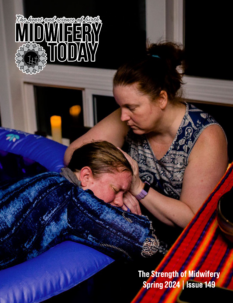
Monet Moutrie—monetnicole.com
First Hours after Birth: Family Integration and Mutual Regulation
Editor’s note: This article first appeared in Midwifery Today, Issue 117, Spring 2016.
Subscribe to Midwifery Today Magazine
The drama after birth sometimes unfolds with comments like these from the mother: “I did it! I did it! I can’t believe I did it!” “Oh my, is that our baby?” “What is it—a boy or girl?” “Is she all right?” “She doesn’t look like a baby!” “Look at her little hands, and her feet!” “We made her!” “She’s so big!” “Look, she has your dimple!” We’ve all heard these outbursts of joy and relief right after the baby comes out, sometimes among kisses, tears of joy and exhaustion or happy laughter.
We’ve also all heard expressions of exhaustion and relief from the mother and seen a temporary lack of interest in her baby. The exclamations might sound more like these: “It’s over! I can’t believe it’s over!” “Can I just lie here for a minute?” “I can’t hold the baby right now. You take it.” ”Please just leave me alone right now.” “I’m so glad it’s over.” “We’re never doing this again!” Sometimes it takes a while before the mother can turn her attention from the intensity of the birth to her baby.
The mother may respond in silence and stillness, moaning a bit as tears flow or crying from relief, joy, or exhaustion, or simply waiting for the next feelings to come as she holds her baby on her chest—feeling him, but not yet really looking at him.
Regardless of how the drama unfolds, the mother’s reaction is correct. Once the intense experience of labor and birth is over, whether orgasmic, ecstatic, triumphant, tedious, disappointing, exhausting or traumatic, she may need time to internalize the reality that she is no longer in labor—it is over and she has her baby. We should trust that her reactions after the birth are correct for her and are the result of a lifetime of experiences, her current circumstances and the nature of this birth experience. No woman should be rushed to hold and suckle her baby any more than she should be rushed to get into labor, dilate her cervix, push her baby and placenta out or latch the baby onto her breast. Nor should her ability to mother her baby be judged by how she responds in these moments.
No matter how she first feels once the baby is born, there is often a pause during which an unrushed mother takes a few moments to get her breath before turning her attention to her baby (Malloy 2011). Labor, which had consumed her entire being for hours, perhaps days, is now in the past. It may take some time to absorb that reality. She may focus immediately on her baby—with curiosity, disappointment, engrossment or rapture. If she has given birth without medications or interventions, her own oxytocin, which began to surge during the baby’s journey down the birth canal, is now at high levels; endorphins are also flowing, and these combine to give the mother high spirits and feelings of love and gratefulness. These hormones also help override the fatigue, pain and discouragement that she may have felt earlier.
The Baby
While all this is going on in the mother, her baby is undergoing an enormous physiological shift from depending on the placenta for survival and growth to depending on himself and his mother to thrive outside the womb—to breathe, take in food, regulate his body temperature and adapt to his new surroundings. While his mother is taking a pause between being pregnant and being a mother, the baby is going through a compelling drama that culminates in his first breaths and cries. Soon, three open shunts that were key to his circulation in utero (foramen ovale and ductus arteriosus in the heart, and the ductus venosus in the liver) close completely to reroute the baby’s circulation through his lungs and liver. This transition from fetal to newborn circulation takes place in about the amount of time it takes for the mother to make her own transition out of labor and focus on her baby.
The Father or Life Partner
The partner has had his own unique experience—the mother may never know what this was. Pride, excitement, indescribable joy, love for mother and baby, relief, gratefulness, exhaustion, shock, insignificance, loneliness, fear, trauma—any or all of these may be felt, but the partner says little about these feelings, as this is not about the partner, but about the mother and the baby. As a rule, his or her feelings are private and unacknowledged. It might be helpful and appreciated if the partner can share these feelings with a trusted friend, family member, doula or midwife.
Other Loved Ones in Attendance
Others who attend the birth may have their own unique experiences as well and may benefit from a chance to talk. Usually all, except the midwife, heave a sigh of relief and joy when the baby is born.
The Midwife (or Nurse, or Doctor)
As the guardian of normal birth, the midwife is not ready to celebrate. She knows there is still much to come before she celebrates. She cannot be swept up completely in the joy and relief of the moment. Though appearing calm in order to preserve a peaceful and reassuring environment, she remains alert and attentive to mother and baby. She assesses their well-being as they make the transition from a unit to a dyad, becoming acquainted with each other’s sights, smells, sounds, tastes and touch. The midwife remains quietly vigilant, knowing that events sometimes take a turn that requires quick action. Midwives all over the world know that the birth is not over when the baby is born, and so they do not relax until the placenta is completely expelled and the mother and baby are stable and healthy.
The Fourth Stage of Labor
The fourth stage, as is true of the third stage, is always defined by what is going on in the mother—beginning after the birth of the placenta and lasting for one to two hours. It is sometimes referred to as the “recovery” or “stabilization” stage, when the mother’s vital signs become stable, all necessary perineal repairs are completed, the uterus remains contracted and there is minimal blood loss. The location of the baby and presence or absence of contact between mother and baby are not included in the definition.
Long ago, Sharon Rising (midwife, now best known for designing the successful Centering Pregnancy Model of group prenatal care) introduced the holistic concept that fourth stage should encompass not only the mother, but the motherbaby dyad or the family triad. As early as 1974, she defined the fourth stage as the stage of “family integration” (Rising 1974).
In 1972, Marshall Klaus, John Kennell and their colleagues suggested that mothers and their infants need to be kept together during a sensitive period of bonding during the first hour after birth. They urged that this process not be interrupted (Klaus et al. 1972). Over the next decades, they further developed this concept of the “sensitive period,” highlighting it as a time when mother and baby tune in to each other and establish very strong bonds. They acknowledged that interruption of mother-infant contact during the sensitive period did not cause long-lasting or irrevocable negative effects, as they had hypothesized earlier (Klaus and Kennell 2001). Their work was pivotal in highlighting the third and fourth stages as times when a great deal of physiological and interpersonal interaction takes place that fosters other outcomes such as neonatal adaptation, breastfeeding and maternal recovery, as described below.
It is inappropriate to discuss the fourth stage in terms of only the mother or the baby, since mothers and babies, as with all other mammals, are normally entwined and mutually dependent on each other. With today’s customary involvement in birth by the father or significant other, the fourth stage also includes other loved ones. They belong close to each other during this time. The midwife, nurse and doula should move into the background, still observant and carrying out their roles unobtrusively.

Tammy Bradshaw—tammybradshawphoto.com
Rising’s expansion of fourth stage to include the baby has been adopted spottily in conventional maternity care. Usual practice still includes removal of the baby from the mother immediately or within a few minutes after birth to an area where the baby can be assessed and given routine medications and procedures (Declerq et al. 2006; Chalmers et al. 2008). Once they are reunited, mother and baby are often rushed to bond and to breastfeed. Maternity care providers have generally been slow to accept the subtle ways an unrushed and undisturbed mother and infant “mutually regulate” each other’s physiological adjustment to their new roles.
Mutual Regulation
“Mutual regulation refers to the influence that mother and baby have on each other’s physiology and behavior, helping to bring them into optimal function” (Buckley 2009, 249). With the baby held close in skin-to-skin contact, not only is the mother providing everything her baby needs—warmth, colostrum, the familiarity of her heartbeat and voice, touch stimulation, smell and more—but the baby is reciprocating by giving her mother some stimulation that she needs for involution, successful breastfeeding and bonding with her baby. The baby’s squirming on her mother’s abdomen and her nuzzling and suckling at the breast releases oxytocin that stimulates the uterus to contract and expel the placenta. The baby’s actions also stimulate mother’s pituitary gland to secrete prolactin, the key to both the production of breast milk and to altruistic maternal behavior (i.e., putting the baby’s needs ahead of her own), which is essential for the survival of the baby. When unrushed and undisturbed, the mother (or both parents) become acquainted with their child and can allow their curiosity to lead them to discover all of the baby’s little details at their own pace (Buckley 2009; Hanson and Simkin 2011).
If the delicate hormonal interaction and mutual regulation between baby and mother or parents are postponed, rushed, disturbed, altered with medications or interrupted by surgery, they may not resume as smoothly when the delay is over. The chances increase for emotional stress for mother and baby, more crying by the baby, temperature drops in the baby, poorer uterine muscle tone, challenges in the initiation of breastfeeding and increased need for medical interventions (Buckley 2009; Hanson and Simkin 2011; Moore, Anderson and Bergman 2007).
Unrushed Breastfeeding
Trends in breastfeeding management have shifted over the years. In the 1960s and 1970s, what might be called the Breastfeeding Renaissance, the art of breastfeeding was being rediscovered. Before then, two generations of doctors and women had become convinced that cow’s milk formula was superior to breast milk. When breastfeeding made its comeback led by La Leche League, a group of mothers who wanted to convince other mothers of the benefits of breastfeeding, it was a matter of reinventing the wheel since so few people knew much about it. During that time, the goal was to get mother and baby together as soon as possible after birth and to get the baby to suckle as soon as possible for the purpose of feeding. The assumption was that newborns are hungry at birth and need to eat immediately. Many techniques were devised to make the baby open his mouth (sometimes the nurse would pry it open with her finger!) to accomplish a “latch” by “ramming” the baby on the nipple whenever his mouth was open (even with crying). The “only right way” for a baby to latch on has given way over the years to a more relaxed approach, thankfully, but we’ve spent a long time recovering from the loss of the art of breastfeeding.
A whole new professional specialty, the lactation consultant, exists today to restore the normalcy and prevalence of breastfeeding. The need for this specialty is a reflection of two things: the degree to which women today have lost confidence in their bodies and the excessive interference in the labor process (induction, augmentation, opioids, epidural analgesia and surgical deliveries, along with policies of separating mothers from their newborns). All these practices interfere with breastfeeding success.
The good news is that today’s advice regarding the latch is much more baby-centered than it was decades ago. We now know that eating is not the first concern of the newborn. He needs to adjust to his new surroundings and his new relationship with his mother. “Baby-led” (Smilie 2008) and “laid-back” (Colson, Meek and Hawdon 2008) breastfeeding, as well as simplified breastfeeding explanations (Mohrbacher and Kendall-Tackett 2010) prevail today. Finally, the World Health Organization’s influence in promoting baby-friendly practices that encourage breastfeeding the world over have increased the level of knowledge and the rates of success in breastfeeding (WHO/UNICEF 1989). Yet, in many industrialized countries, hospital practices have not kept pace with knowledge of best breastfeeding practices, and women still struggle to maintain breastfeeding rates through the first days and weeks after birth. A better start during the fourth stage of labor with unrushed and undisturbed mother and baby lying together skin-to-skin will increase successful breastfeeding relationships.
Singing to Baby Before and After Birth
Finally, I can’t write about the fourth stage of labor without discussing a most delightful and meaningful custom—choosing one song and singing it to the baby regularly before and after birth. I’ve become passionate about this idea and hope readers will feel the same.
Here is what I suggest to expectant parents (Simkin 2011):
- Any time after about 32 weeks gestation (when the fetus’s hearing is developed), pick a song that is easy to sing—one that you like very much.
- Every day, one or both parents sing the song aloud to the baby.
- After the first few minutes of lung-clearing crying have passed, sing this song to greet your baby, and frequently thereafter, to soothe, reassure and calm the baby. The baby knows and likes her song being sung by the familiar voices she has known almost all her life.
It becomes the baby’s song—a wonderful technique for singing her to sleep or soothing her when fussy (but not hungry).
Is singing better than reading or talking to the baby? Perhaps it is, because with music plus words, both sides of the brain are stimulated. Is singing better than playing recorded music for the baby? Yes, because, the parents’ familiar voices (even if off-key) add a very special dimension. Their voices are always with them—there is no need for audio equipment.
Here are some heartwarming stories from parents who sang to their babies in utero:
A baby boy was greeted in the operating room after being born by cesarean by his dad singing, “Here Comes the Sun.” This was the only familiar thing for the baby, who calmed and oriented toward his father, bringing tears to the eyes of some medical staff (and me, the doula).
A little girl, born after a normal vaginal birth, basked contentedly between her parents as they sang, “You Are My Sunshine.” Later they would sing it to her in the car when she’d cry and they couldn’t stop to cuddle her. It would calm her down.
A little girl, born without incident after passing meconium, shockingly could not breathe after birth. While in the neonatal intensive care unit on life support with severe meconium aspiration syndrome, her parents sang her song, “Julia,” to her frequently. Every time, her vital signs improved. Her need for morphine decreased. The staff were moved and thrilled to see her improvement, and the parents realized they could help their baby as no one else could! She is developing normally today.
Please suggest this idea to your clients. Every birth you attend will be so gratifying, and your clients will be empowered with the special gift only they can give their baby.
Conclusion
The conventional definitions of third and fourth stages include only the mother, and the baby is customarily removed from the mother and returned sometime later wrapped in a blanket, having received medications and assessments. The time after birth is a time when mother and baby belong together, unrushed and undisturbed as they adjust together to their new roles. Once the placenta has been born, the fourth stage is a time for stabilization of mother and baby, family integration and mutual regulation. Both mother and child benefit from skin-to-skin contact.
We’ve reviewed many of the benefits of a holistic approach to the fourth stage of labor, treating the motherbaby dyad as inseparable. By singing before and after birth, parents have a heartwarming and practical way to soothe and communicate with their baby.
References:
- Buckley, S. 2009. Gentle Birth, Gentle Mothering. Berkeley: Celestial Arts.
- Chalmers, B, et al. 2008. “The Canadian Maternity Experiences Survey: An overview of findings.” JOGC 30:217–28.
- Colson, SD, J Meek and JM Hawdon. 2008. “Optimal Positions Triggering Primitive Neonatal Reflexes Stimulating Breastfeeding.” Early Hum Dev 84 (7): 441–49.
- Declerq, E, et al. 2006. Listening to Mothers II: Report of the Second National U.S. Survey of Women’s Childbearing Experiences. New York: Childbirth Connection.
- Hanson, L, and P Simkin. 2011. “Optimal Newborn Transition and Third and Fourth Stage Labor Management.” In The Labor Progress Handbook: Early Interventions to Prevent and Treat Dystocia, 3rd ed., by P Simkin and R Ancheta, 224–41. Oxford: Wiley-Blackwell.
- Klaus, MH, et al. 1972. “Maternal Attachment: Importance of the First Post-Partum Days.” N Eng J Med 286:460–63.
- Klaus, MH and JH Kennell. 2001. “Care of the Parents.” In Care of the High-Risk Neonate, 5th ed, edited by MH Klaus and AA Fanaroff, 195–222. Philadelphia: Saunders.
- Malloy, ME. 2011. “Waiting to Inhale: How to Unhurry the Moment of Birth.” J Perinat Ed 20:8–13.
- Mohrbacher, N, and K Kendall-Tackett. 2010. Breastfeeding Made Simple: Seven Natural Laws for Nursing Mothers. Oakland: New Harbinger.
- Moore, ER, GC Anderson and N Bergman. 2007. “Early Skin-To-Skin Contact for Mothers and Their Healthy Newborn Infants.” Cochrane Database of Systematic Reviews 3:CD003519.
- Rising, SS. 1974. “The Fourth Stage of Labor: Family Integration.” Am J Nurs 74 (5): 870–74.
- Simkin, P. 2011. “Singing to the Baby Before and After Birth.” International Doula 19 (3): 30–31.
- Smillie, C. 2008. “How Infants Learn to Feed: A Neurobehavioral Model.” In Supporting Sucking Skills in Breastfeeding Infants, edited by CW Genna, 79–95. Boston: Jones & Bartlett.
- WHO/UNICEF. 1989. “Joint Statement Protecting, Promoting and Supporting Breastfeeding: The Special Role of Maternity Services.” http://whqlibdoc.who.int/publications/2009/9789241594967_eng.pdf.

 Penny Simkin, PT, is a physical therapist who has specialized in childbirth education since 1968. She estimates she has prepared over 14,000 women, couples and siblings for childbirth, and is a co-founder of DONA International. Today her practice consists of childbirth education, birth counseling, and writing, combined with a busy schedule of conferences and workshops. Penny and her husband, Peter, have four grown children, eight grandchildren, three grandchildren-in-law, and a pug named Lola.
Penny Simkin, PT, is a physical therapist who has specialized in childbirth education since 1968. She estimates she has prepared over 14,000 women, couples and siblings for childbirth, and is a co-founder of DONA International. Today her practice consists of childbirth education, birth counseling, and writing, combined with a busy schedule of conferences and workshops. Penny and her husband, Peter, have four grown children, eight grandchildren, three grandchildren-in-law, and a pug named Lola.
















